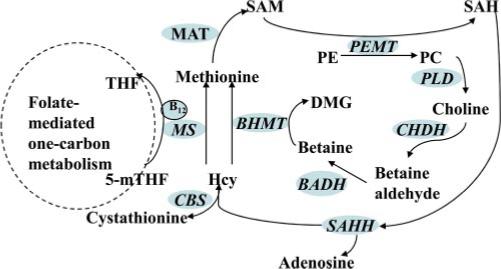Figure 1.

Schematic illustration for choline metabolism. Folate, choline, and methionine metabolism interact at the point at which homocysteine (Hcy) is converted to methionine. Folate mediates the generation of methionine using the methyl group, i.e., 5-methyltetrahydrofolate (5-mTHF), which is derived de novo from the one-carbon pool; alternatively, the methyl group of choline can be made available on conversion to betaine for the methylation of homocysteine. CHDH converts choline to betaine aldehyde, which can then be oxidized in the mitochondria or cytoplasm to betaine. BHMT catalyzes the methylation of homocysteine, using betaine as the methyl donor. SAM is converted following the regeneration of methionine by methionine adenosyltransferase (MAT). THF, tetrahydrofolate; MS, methionine synthase; SAH, S-adenosyl-l-homocysteine; PE, phosphatidylethanolamine; PC, phosphatidylcholine; PLD, phospholipase D; SAHH, S-adenosyl homocysteine hydrolase; BADH, betaine aldehyde dehydrogenase; DMG, N,N-dimethylglycine; CBS, cystathionine β-synthase.
